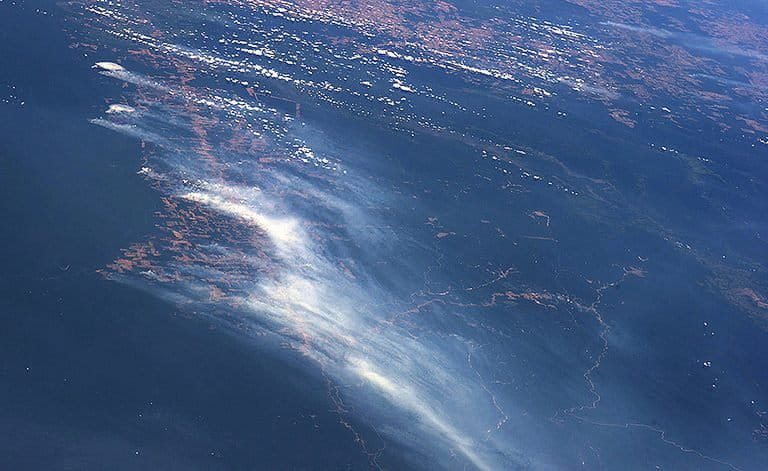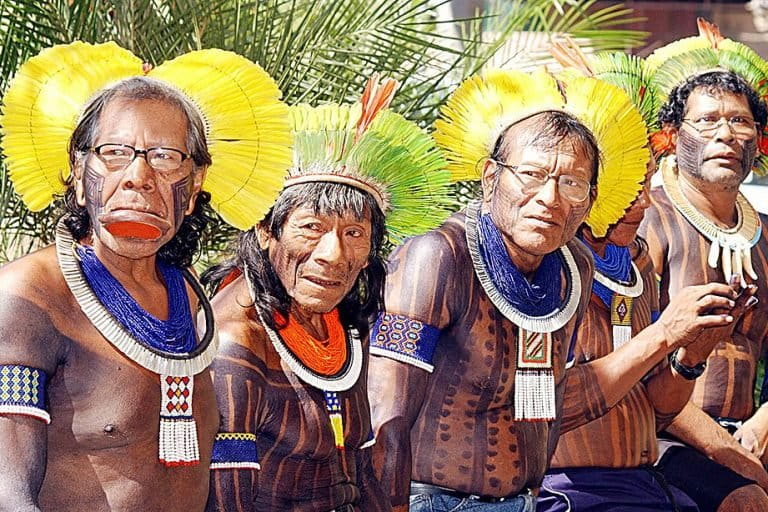- As of September 2017, Brazil’s Pará state in the Amazon had seen a 229 percent increase in fires over 2016; in a single week in December the state saw 26,000 fire alerts. By year’s end, the Brazilian Amazon was on track for an all-time record fire season.
- But 2017 was not a record drought year, so experts have sought other causes. Analysts say most of the wildfires were human-caused, set by people seeking to convert forests to crop or grazing lands. Forest degradation by mining companies, logging and agribusiness added to the problem.
- Huge cuts made by the Temer administration in the budgets of Brazilian regulatory and enforcement agencies, such as FUNAI, the nation’s indigenous protection agency, and IBAMA, its environmental agency, which fights fires, added to the problem in 2017.
- The dramatic rise in wildfires has put indigenous communities and their territories at risk. For example, an area covering 24,000 hectares (59,305 acres), lost tree cover within the Kayapó Indigenous Territory from October to December, while the nearby Xikrin Indigenous Territory lost roughly 10,000 hectares (24,710 acres) over the same period.

There were nearly 26,000 fire alerts in the Brazilian Amazon state of Pará over a single week in December of last year, according to Global Forest Fires Watch. And as of September, Pará had seen a stunning 229 percent increase in fires over 2016, as reported by the Guardian newspaper, with 2017 on track to be Brazil´s worst ever fire year, according the World Resources Institute (WRI).
But statistics tell only part of the story: Brazil’s likely record wildfire season last year incinerated vast swathes of valuable trees, habitat and wildlife, sometimes within indigenous territories, natural resources which native communities rely on for their survival.
WRI estimates that an area nearly double the size of San Francisco, 24,000 hectares (59,305 acres), lost tree cover within the Kayapó Indigenous Territory from October to December 2017 due to fires, while the nearby Xikrin Indigenous Territory lost roughly 10,000 hectares (24,710 acres) over the same period.

The World Resources Institute´s Places to Watch report notes that these particular fires were not completely natural, but likely exacerbated by “previous degradation. In the 1990s, a logging company exploited an agreement with Xikrin and left the territory over-logged and severely degraded.” Timber removal not properly carried out leaves heaps of slash behind, waste limbs and branches that dry in a drought and serve as tinder for forest fires.
Importantly, say experts, while the Amazon in general, and Pará state in particular, suffered drought last autumn, this dry spell did not set a record or explain the remarkably high number of fires. The director of Brazil´s National Institute for Space Research, Alberto Setzer, told the Guardian that there is another explanation for the record blazes: “It is fundamental to understand that these are not natural fires. They are manmade.”
Fire in the Brazilian Amazon, according to analysts, is often being used as a tool to convert the region’s forests into pasture and cropland; often fire is even employed as a means of settling land conflicts.

The revised Brazilian forestry code introduced in 2012 may be partly to blame; it gave amnesty to those guilty of illegal deforestation. In fact, deforestation has risen steadily across the Amazon region since then, with a 29 percent increase between 2015 and 2016.
The many wildfires threatening the Xikrin indigenous community on the Cateté River last fall weren’t only catalyzed by the lingering degradation of over-eager loggers twenty years ago. In mid-September, a federal court ordered Brazilian mining giant Vale to shut down its Onça Puma nickel mine near the indigenous territory and to suspend operations until the company complies with the terms of its environmental license and pays some 50 million Reals (US$ 15 million) in damages to the Xikrin and Kayapó communities.
A report filed by Brazil´s investigative news outlet, Agencia Publica, at the start of December, told how Vale mines nickel on hills near the Xikrin territory and described its mill, located a mere six kilometers (3.7 miles) from the indigenous territory’s boundary. The Xikrin´s land is surrounded by mineral wealth, including the world’s largest iron deposit (and the gigantic Carajás iron mine); along with Brazil´s largest copper reserve; plus an exceptionally pure nickel deposit. The area is also known for its biodiverse rainforest, with towering Brazil nut trees that produce bumper crops of the popular nut.
Mining – both legal and not – and illegal logging, along with hunting, all vitiate forest integrity, says Eric de Belém Oliveira, a former regional coordinator for Brazil´s indigenous policy and protection service, FUNAI. And that forest degradation, can make fires more intense and wide ranging once they start.

“The flexibility that Brazilian law has introduced into its environmental regulations [since 2012] show that its [regulatory and enforcement] agencies don’t represent institutional power anymore,” Oliveira told Mongabay. “Now it’s [global] capital that calls the shots.”
Oliveira worked his way up in FUNAI, starting ten years ago as an intern. But he was laid off last March from his position as the Marabá regional coordinator, a victim of massive draconian budget cuts occurring under the President Michel Temer. Oliveira’s position is still empty nearly a year after his departure. The regional office serves some 7,000 indigenous people in 120 different villages.
“We had 20 people, and we lost seven to retirement,” Oliveira told Mongabay. None of these vacancies have been filled. “Since there isn’t anyone to handle situations, this has worsened [conditions] for indigenous communities. In reality, the indigenous villages where we work are suffering serious impacts.” The FUNAI office serving the populations affected by the Belo Monte mega-dam are likewise reportedly understaffed, with similar adverse impacts to the wellbeing of indigenous communities.


The Temer administration has been starving FUNAI’s budget. A May statement from the Institute for Socioeconomic Studies said that the agency had suffered a 50 percent reduction in its discretionary budget, dropping from 110.6 million Reals to 49.9 million Reals. The Ministry of the Environment, which houses Brazil’s environmental agency, IBAMA, saw cuts of 43 percent. IBAMA´s many duties include fighting the nation’s forest fires. IBAMA´s budget decreased from 977 to 446 million Reals (US$ 302.9 million to US$ 138.3 million). The cuts left the agency without funds to pay for transportation, electricity and Internet.
Oliveira pointed to the Fundão mining tailings dam collapse in Minas Gerais, Brazil’s worst environmental disaster ever, as an indicator of what he says is happening across his nation: “You can see an overall lack of monitoring. And instead of adopting stricter legislation, you see the opposite happening. We see that the advance of [transnational and Brazilian] companies hasn’t just caused environmental impacts, but also [done] damage to relationships among indigenous people because they’ve contributed to internal conflicts.”
FUNAI said that it did not have the capacity to respond to questions from Mongabay about its staffing levels or forest degradation on indigenous lands.
FEEDBACK: Use this form to send a message to the author of this post. If you want to post a public comment, you can do that at the bottom of the page.

